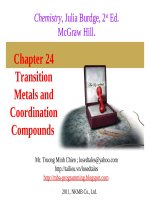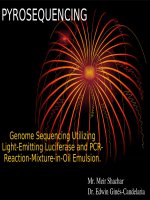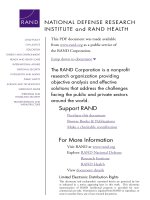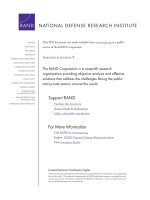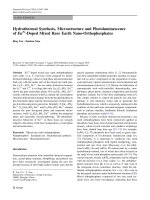Transition metal and rare earth doped stoichiometric lithium niobate crystals for holographic recording
Bạn đang xem bản rút gọn của tài liệu. Xem và tải ngay bản đầy đủ của tài liệu tại đây (2.37 MB, 186 trang )
TRANSITION METAL AND RARE EARTH DOPED
STOICHIOMETRIC LITHIUM NIOBATE CRYSTALS FOR
HOLOGRAPHIC RECORDING
SANJEEV SOLANKI
NATIONAL UNIVERSITY OF SINGAPORE
2004
TRANSITION METAL AND RARE EARTH DOPED
STOICHIOMETRIC LITHIUM NIOBATE CRYSTALS FOR
HOLOGRAPHIC RECORDING
SANJEEV SOLANKI
(M.Tech)
A THESIS SUBMITTED FOR THE DEGREE OF DOCTOR
OF PHILOSOPHY DEPARTMENT OF ELECTRICAL &
COMPUTER ENGINEERING NATIONAL UNIVERSITY OF
SINGAPORE
2004
i
Acknowledgements
First and foremost, I would like to thank my Ph.D. supervisors Prof. Chong Tow
Chong (Department of Electrical and Computer Engineering, National university of
Singapore & Data Storage Institute, Singapore) and Dr Xu XueWu (Data Storage
Institute, Singapore), whose breadth of knowledge, outstanding communication
skills and organizational ability assured this project’s clarity and completeness. In
particular, thanks to Dr Xu Xuewu, who first introduced me to the holographic
recording material growth methods and constant wake my interest in the
fundamental research. In these years, their brilliance and wise counsel; their
unique insights and perspectives and noteworthy talents and dedication,
accompany me throughout the program.
I would like to thank a number of people: Dr Liang Xinan for constant discussions
and also for crystal sample etching and provide the single domain data for as
grown crystals. My Yongsoon Tay for polishing crystal samples and Dr Xuwei on
providing vertical temperature gradient data of growth furnace. Thanks are also
due to Mr Yuan Shaoning for his contribution in developing various experimental
setups.
Finally, I would like to convey deep appreciation for my wife for her endless
support for all these years. She has been a constant support and encouragement.
I dedicate this thesis to her and all my teachers.
ii
Summary
We used TSSG (top seeded solution growth method) to grow undoped and
doped SLN crystal samples at very low vertical temperature gradient. We
thoroughly studied the effect of coherent laser beams on doped SLN crystals and
finally performed high speed and high density holographic recording.
Developed low vertical temperature gradient flux growth method to grow
high quality undoped and doped stoichiometric lithium niobate crystals. Growth
was performed mainly along two directions. One was the normal to the facet
(012), (1-12), or (-102). The other one was perpendicular to both the normal to the
facet and X axis Crystal samples of 300 mm in height and 18 mm in diameter
were obtained by this method. Optical characterization method was used to
confirm the stoichiometric composition of undoped as well as doped (Fe,Mn,Tb)
SLN crystals. The shift in OH
-1
vibration peak supported the stoichiometric
composition of doped crystals. Furthermore the non existence of a Raman peak
at 740 cm
-1
confirmed the non- existence of antisite intrinsic defect even in highly
doped SLN crystals.
Beam fanning in doped SLN crystals was found to be deterministic
compared to doped CLN crystals, which showed random beam fanning. The
backward fanning in Z – cut crystals was relatively weak in Tb containing SLN
crystals and the transmitted beam spot always preserved its shape. But for doped
CLN crystal the transmitted beam spot was highly distorted. Further Z – cut SLN
crystals were able to sustain very high incident power density of ~150kW/cm
2
.
iii
Plane wave hologram recording with increasing power densities was performed in
doped SLN crystals. Total recording time ~1sec was obtained at total recording
power density of 70W/cm
2
. Ultra high speed image recording was performed at
total recording power density of ~81kW/cm
2
and the image was successfully
retrieved for recording time of ~1msec, which was 2-3 order faster than previously
reported hologram recording time. For example Burr et al. reported average
recording time per hologram of ~0.34 sec [86] and Mok et. al. ~1 sec [24,33].
Shift –multiplexing method was implemented using focused signal beam
and diverging reference beam to store matrix of 3 X 3 holograms. Holograms
were recorded with in-plane shift of 100 µm and out-of plane shift of 300 µm,
which is similar to the results reported for recording with diverging/converging
signal beam [120]. At the IR (778 nm) recording and UV (365 nm) gating, SLN
crystal samples with low Tb doping concentration showed better performance
from non-volatility point of view, i.e. readout of recorded hologram resulted in slow
erasing of recorded hologram. The erasing time constant of recorded hologram
was ~5 times slower in SLN crystal with 0 ppm Tb than in SLN with 140 ppm Tb.
iv
Contents
Acknowledgements i
Summary ii
Contents iv
List of Tables viii
List of Figures ix
1. INTRODUCTION 1
1.1. Photorefractive (PR) effect 1
1.2. Theory – PR in crystals 3
1.3. Applications 4
1.4. Media for holographic recording 5
1.5. Stoichiometric lithium niobate 7
1.6. Thesis overview 8
2. Crystal Growth 11
2.1 Introduction 11
2.2 Growth of undoped and doped SLN crystals 12
2.2.1 Stoichiometric undoped 12
2.2.2 Stoichiometric doped 19
2.2.3 Stoichiometric doubly doped 20
2.2.3 Stoichiometric triply doped 20
v
2.3 Morphology 21
2.3.1 Crystal structure and effect of growth direction 21
2.4 XRD Analysis 26
2.4.1 Powder XRD 26
2.3.2 Crystal Orientation 28
2.3.3 Summary 31
Appendix2.1 32
3. Optical Characterization 34
3.1 Introduction 34
3.2 Absorption spectra 35
3.2.1 Absorption edge 35
3.2.2 Effect of doping and annealing on absorption edge 40
3.2.3 Effect of doping and annealing on Optical Spectra 41
3.3 OH
-1
spectra 45
3.3.1 Stoichiometric composition 45
3.3.2 Effect of doping 46
3.4 Raman spectra 48
3.4.1 Theory 48
3.4.2 Effect of stoichiometry 49
3.4.3 Summary 54
4. Beam Fanning 55
4.1 Introduction 55
vi
4.2 Backward Beam Fanning – Two-wave mixing 56
4.2.1 Theory – (dynamic & steady state) 56
4.2.2 Experiments and results – Z- Cut Fe:SLN 62
4.2.3 Experiments and results – Z- Cut Fe:Tb:SLN 70
4.3 Transverse Beam Fanning 78
4.3.1 Theory – (steady state) 78
4.3.2 Experiments and results – X- Cut Fe:SLN 79
4.3.3 Experiments and results – X- Cut Fe:Tb:SLN 85
4.3.4 Summary 87
5. One – Color Holographic Recording 89
5.1. Introduction 89
5.2. One – color theory 91
5.3. Effect of Non-Reciprocal energy Transfer on diffraction efficiency 94
5.4. Experiments and results 103
5.4.1. Hologram recording with green light (~1W/cm
2
) 103
5.4.2. Sensitivity and M/# 106
5.4.3. Hologram recording with IR light 109
5.5. High speed recording 110
5.5.1. Plane – wave Recording 110
5.5.2. Image Recording 120
5.5.3. Shift Multiplexing 123
5.5.4. Summary 129
vii
6. Two – Color Holographic Recording 130
6.1. Introduction 130
6.2. Two – color theory 131
6.3. Experiments and results 135
6.3.1. Hologram recording UV gating and green recording light 135
6.3.2. Hologram recording UV gating and IR recording light 141
6.3.3. Summary 148
7. Conclusion 149
Bibliography 152
Journal papers 168
International Conference papers 169
viii
List of Tables
Table 2.1. Interplanner angles between crystallographic planes.
Table 2.2. X Ray Diffraction angle from X,Y,Z and facet planes.
Table.2.3. The dnh,nk,nl calculated with the above cell parameters and extinction
condition are listed.
Table 3.1. Comparison of fundamental absorption edge and raman mode line-
width of CLN and SLN crystals. Also shown the effect of doping and annealing
conditions on absorption edge.
Table4.1 Transmitted light intensity of different Z-cut crystal samples at different
incident laser power density
Table.4.2 Threshold power density (I
th
≡ W/cm
2
) of X-cut crystal samples
Table 5.1. Measured sensitivity and M/# for one – color recording in reflection
geometry at nm532
=
λ
.
Table 5.2. Results of experiments performed with Fe:Tb:SLN-1 crystal sample.
ix
List of Figures
Fig.1.1. Light induced optical damage.
Fig.1.2. Recording and reconstruction of image hologram.
Fig.2.1. TGA of K
2
CO
3
powder sample.
Fig.2.2. Sintering cycle.
Fig.2.3. Crystal growth cycle.
Fig.2.4. Sketch of crystal growth furnace.
Fig.2.5. Crystallization temp. T
C
Vs K
2
O concentration.
Fig.2.6. Crystal sample grown along X – axis.
Fig.2.7. Crystal sample grown along Z – axis.
Fig.2.8. 1
st
Crystal sample grown along facet – axis.
Fig.2.9. 2
nd
Crystal sample grown along facet – axis.
Fig.2.10. Fe:Tb:Mn:SLN crystal with 750 ppm Fe, 140 ppm Tb and 100 ppm Mn in
melt.
Fig.2.11. Crystal grown along Z – axis.
Fig.2.12. Sketch of end-on view of a LiNbO
3
crystal grown along Z axis (Fig.2.11)
with facet indices.
Fig.2.13. 32 mm long SLN crystal sample grown along perpendicular to facet
plane [(012), (1-12), (-102)].
Fig.2.14. Theoretically calculated XRD pattern of LiNbO
3
crystal powders.
Fig.2.15. Powder XRD pattern of LiNbO
3
crystal grown from 19 mol% K
2
O.
Fig.2.16. Powder XRD pattern of LiNbO
3
crystal grown from 16 mol% K
2
O.
Fig.2.17. Powder XRD pattern of LiNbO
3
crystal grown from 16 mol% K
2
O +
ceramic inclusions.
x
Fig.2.18. Lapped Z – face (of low temp. gradient TSSG grown doped SLN crystal)
oriented using Rigaku X-ray goniometer.
Fig.3.1. Measured reflection spectra with crystal sample thickness.
Fig.3.2. Transmission spectra of 0.7 mm thick SLN (19 mol%K
2
O – solid), (16
mol%K
2
O – dash).
Fig.3.3. Transmission spectra of 2mm thick SLN (solid) and CLN (dash) Z-Cut
crystal sample.
Fig.3.4. Absorption edge of SLN (solid) and CLN (dash).
Fig.3.5. Absorption edge of doped SLN crystals.
Fig.3.5. OH
-1
spectra of SLN (solid) and CLN (dash) crystals.
Fig.3.6. Absorption spectra of Fe(600 ppm):CLN and Fe(100ppm):SLN crystal
sample.
Fig.3.7. Absorption spectra of Fe:Tb(100:10 ppm):SLN and Fe:Tb
(100:140ppm):SLN crystal sample.
Fig.3.8. Absorption spectra of Oxidized and reduced Fe:Mn:Tb(100:10:140
ppm):SLN crystal sample.
Fig.3.9. Absorption spectra of Oxidized and reduced Fe:Mn:Tb(750:100:140
ppm):SLN crystal sample.
Fig.3.10. OH
-1
spectra of SLN (solid) and CLN (dash) crystals.
Fig.3.11. OH
-1
spectra of Fe:SLN (solid) and Fe:Tb:SLN (dash) crystals.
Fig.3.12. OH
-1
spectra of Fe:Mn:Tb:SLN-1 (solid) and Fe:Mn:Tb:SLN-2 (dash)
crystals.
Fig.3.13. Raman spectra of SLN (solid) and CLN (dash) crystals.
Fig.3.14. Raman spectra of X – Cut SLN (solid) and CLN (dash) crystals.
Fig.3.15. E(TO) – 152 cm
-1
of SLN (solid) and CLN (dash) crystals.
Fig.3.16. A
1
(LO) – 875 cm
-1
of SLN (solid) and CLN (dash) crystals.
Fig.3.17. Ilmenite like stacking defect creates line at 740 cm
-1
in CLN (dash)
disappears in SLN (solid).
xi
Fig.3.18. Ilmenite like stacking defect creates line at 740cm
-1
in also disappears in
Fe:Mn:Tb:SLN-2 crystal sample.
Fig.4.1. Experimental setup: L – lens, A1, A2 – aperture, PM – powermeter.
Fig.4.2. Orientation of polar axis (c
+
,c
-
) of LN crystal.
Fig.4.3. Temporal evolution of the transmitted light intensity for the light incident
along c
+
and c
-
axes of Z-cut Fe:SLN.
Fig.4.4. Plot of the beam-fanning factor (BFF) with the incident power density I
p
for the light incident along the c
+
and c
-
axes of Z-cut Fe:SLN.
Fig.4.5. Temporal evolution of the transmitted light intensity for the light incident
along c
+
and c
-
axes of Z-cut Fe:CLN.
Fig.4.6. Beam-fanning factor BFF with the incident power density I
p
for the light
incident along the c
+
and c
-
axes of Z-cut Fe:CLN.
Fig. 4.7. Transmitted beam spots: (a) k||c
+
, Fe:SLN; (b) k||c
-
, Fe:SLN; (c) k||c
+
,
Fe:CLN; (d) k||c
-
, Fe:CLN.
Fig.4.8. (a). Backward scattered light for k
p
||c
+
, Fe:SLN and (b) for k
p
||c
+
,
Fe:CLN.
Fig.4.9. Simulation results of the temporal evolution of the transmitted light
intensity for the light incident along c
+
and c
-
axes of Z-cut Fe:SLN.
Fig.4.10. Temporal evolution of the transmitted light intensity incident along c
-
–
axis at I
P
= 3.6 W/cm
2
.
Fig.4.11. Temporal evolution of the transmitted light intensity incident along c
+
–
axis at I
P
= 3.6 W/cm
2
.
Fig.4.12. Beam-fanning factor BFF with the incident power density I
p
for the light
incident along the c
-
axes of Z-cut crystal samples.
Fig.4.13. Beam-fanning factor BFF with the incident power density I
p
for the light
incident along the c
+
axes of Z-cut crystal samples.
Fig.4.14. Transmitted spot images of the laser beam at power density of 72
W/cm
2
for +Z faces of the Z-cut crystal samples: (a) Fe:CLN; (b) Fe:SLN; (c)
Fe:Tb:SLN-1; (d) Fe:Tb:SLN-2.
Fig.4.15. Scattering ratio of –Z face of the Z-cut Fe:Tb:SLN crystal samples at
very high incident power density.
xii
Fig. 4.16. Transmitted spot images of the laser beam at incident power density of
152 kW/cm
2
for the Z-cut crystal samples: (a) –Z, Fe:CLN; (b) +Z, Fe:CLN; (c) –Z,
Fe:SLN; (d) +Z, Fe:SLN; (e) –Z, Fe:Tb:SLN-1; (f) +Z, Fe:Tb:SLN-1; (g) –Z,
Fe:Tb:SLN-2; (h) +Z, Fe:Tb:SLN-2.
Fig.4.17. Temporal evolution of the transmitted light intensity for the e-polarized
light incident along the X – axis of Fe:SLN.
Fig.4.18. Temporal evolution of the transmitted light intensity for the e-polarized
light incident along the X – axis of Fe:CLN.
Fig. 4.19. Plot of the beam-fanning factor BFF with the incident power density Ip
for the light incident along the X - axis of (a) Fe:SLN and (b) Fe:CLN.
Fig.4.20. Transmitted beam spots at t=1hr: (a) k||X, Fe:SLN; (b) k||X, Fe:CLN.
Fig.4.21. Transmitted beam spot at minima for k||X, Fe:SLN
Fig.4.22. Temporal evolution of the transmitted light intensity at 5 W/cm2 incident
beam power density.
Fig.4.23. Beam-fanning factor BFF with the incident power density I
p
for the light
incident along the X axes of X-cut crystal samples.
Fig. 4.24. Transmitted spot images of the laser beam at 7.2 W/cm
2
in the X-cut
crystal samples: (a) Fe:SLN; (b) Fe:Tb:SLN-1; (c) Fe:Tb:SLN-2.
Fig.5.1. Band transport model
Fig.5.2. Reflection Geometry
Fig.5.3. Experimental setup
Fig.5.4. Sketch of gratings inside the crystal
Fig.5.5. Change of the transmitted power with time for the incident beam along c
+
and c
-
axes.
Fig.5.6. Diffraction efficiency for Fe:SLN measured with diffracted beam along c
+
(circle) and c
-
(square) axes.
Fig. 5.7. Diffraction efficiency for Fe:CLN measured with diffracted beam along c
+
(circle) and c
-
(square) axes.
Fig. 5.8. Simulated curves for beam coupling due to surface reflection for the
incident beam along c
+
(dash) and c
-
(solid) axes.
xiii
Fig. 5.9. Simulated curves for diffraction efficiency including beam coupling due to
surface reflection for the incident beam along c
+
(dash-dot) and c
-
(dash) axes.
Solid line corresponds to the diffraction efficiency when the surface reflection
effect is not taken into account.
Fig. 5.10. Diffraction efficiency for Fe:CLN measured with diffracted beam along c
-
- axis.
Fig.5.11. Diffraction efficiency for Fe:SLN measured with diffracted beam along c
-
axes.
Fig.5.12. Diffraction efficiency for Fe:Tb:SLN-1 measured with diffracted beam
along c
-
axes.
Fig.5.13. Diffraction efficiency for Fe:Mn:Tb:SLN measured with diffracted beam
along c
-
axes.
5.14. Diffraction efficiency for Fe:Mn:Tb:SLN with recording at 778 nm.
Fig.5.15. Experimental setup for high speed plane wave holographic recording
Fig.5.16. Recording and erasing curve for Z-cut Fe:Tb:SLN-1 at I
recording
= 0.35
W/cm
2
.
Fig.5.17. Recording and erasing curve for Z-cut Fe:Tb:SLN-1 at I
recording
= 8.08
W/cm
2
.
Fig.5.18. Recording and erasing curve for Z-cut Fe:Tb:SLN-1 at I
recording
= 17.06
W/cm
2
.
Fig.5.19. Recording and erasing curve for Z-cut Fe:Tb:SLN-1 at I
recording
= 70.03
W/cm
2
.
Fig.5.20. The plot of measured sensitivity with the total recording power density.
Fig.5.21. The plot of measured M/# with the total recording power density.
Fig.5.22. Response time with Recording power density in range (~0.3 – 70
W/cm
2
).
Fig.5.23. Response time with Recording power density in range (~6 – 70 W/cm
2
).
Fig.5.24. Linear fit (eqn.5.15) to response time Vs power density data.
Fig.5.25. Experimental setup for recording and reconstruction of an image-bearing
hologram: ND – neutral density filter; BS – beam splitter; L1, L2 – lens (110 mm);
xiv
M1, M2 – mirror; BE – beam expander; CNTT – chromium negative test target;
CCD – camera.
Fig.5.26. Reconstructed image-bearing hologram stored within (a) 1 msec, (b) 2
msec, (c) 3 msec and (d) 10 msec in the Z-cut Fe:Tb:SLN-1 crystal; (e) Direct
transmitted image from the crystal.
Fig.5.27. Experimental setup for recording and reconstruction of shift-multiplexed
mage-bearing holograms.
Fig.5.28. Sketch of matrix of 3 X 3 (9) holograms stored using shift multiplexing
with shift ∆X along X – direction and ∆Y along Y – direction.
Fig.5.29. 9 pictures stored in 3 × 3 matrix in a Z-cut Fe:Mn:Tb:SLN crystal plate
(2.5 mm in thickness) using exposure times of the order of 10 msec.
Fig.5.30. Sketch of shift-multiplexing method.
Fig.6.1. Two – Color Band transport model: 1,3 – deep trap, 2 – shallow trap
Fig.6.2. Experimental setup for Two – Color holographic recording using green
recording light and UV gating light.
Fig.6.3. Recording of hologram using 5W/cm
2
recording density and 200mW/cm
2
gating light density.
Fig.6.4. Second recording of hologram using 5W/cm
2
recording density and no
gating light.
Fig.6.5. Recording of hologram using pre-sensitized crystal sample with total
recording power density at 1W/cm
2
and 5W/cm
2
.
Fig.6.6. Recording of hologram in Fe:SLN crystal sample using 5W/cm
2
recording
density and 200mW/cm
2
gating light density.
Fig.6.7. Second recording of hologram in Fe:SLN using 5W/cm
2
recording density
and no gating light
Fig.6.8. Experimental setup for Two – Color holographic recording using IR
recording light and UV gating light.
Fig.6.9. Results of two color experiment performed with Fe:Mn:Tb:SLN-2 crystal
sample with 6W/cm
2
of recording light and 100 mW/cm
2
of gating light.
Fig.6.10. Results of two color experiment performed with Fe:Mn:Tb:SLN-1 crystal
sample with 6W/cm
2
of recording light and 80 mW/cm
2
of gating light.
xv
Fig.6.11. Results of two color experiment performed with Fe:Tb:SLN-1 crystal
sample with 6W/cm
2
of recording light and 100 mW/cm
2
of gating light.
Fig.6.12. Results of two color experiment performed with Fe:SLN crystal sample
with 6W/cm
2
of recording light and 80 mW/cm
2
of gating light.
Fig.6.13. IR erasure during readout of holograms of doped SLN crystal samples.
Fig.6.14. Decay rate of stored hologram with the amount of Tb inside the crystal.
1
1. INTRODUCTION
1.1. Photorefractive (PR) effect
The photorefractive effect was first noticed as ‘optical damage’ by Ashkin
et. al. 1966 [1] at Bell labs in mid sixties. It was called ‘optical damage’ at that time
because, when intense laser light from pulse laser focused on ferroelectrics like
LiNbO
3
and LiTaO
3
, it produced local semi-permanent changes in refractive index
of these materials as shown in Fig.1.1 . The laser beam spot was circular in
shape (Fig.1.1) before it produces optical damage inside the lithium niobate
crystal.
Fig.1.1. Light induced optical damage [1].
2
In the late sixties, Chen and his co-workers showed that this ‘optical
damage’ in ferroelectric should be used for high-density optical storage of data.
Chen was also the first to propose ‘charge transport model’ Chen et. al. [2], 1970
[3] specific to these ferroelectric materials. After gaining knowledge of some more
photorefractive materials like SBN and BaTiO
3
, Amodei and Staebler et. al.
1971[4], [5] in 1972 gave the general model for charge migration. Amodei et. al.
1971 [6], 1972[7] and 1979 [17] in their work showed that charge migration by
diffusion plays an important role in holographic recording for sufficiently small
grating spacing and derived expressions for the electric field patterns generated
through drift and diffusion for plane wave holograms.
Fig.1.2. Recording and reconstruction of image hologram [3].
In 1974, Glass et. al. [10] introduced one more effect in LiNbO
3
crystals
together with drift and diffusion and named this effect as bulk photovoltaic effect.
This effect was due to the asymmetry of the crystal, which caused photo-ionized
3
carriers to be ejected into the conduction band in a particular direction relative to
optics axis of the crystal, thus giving rise to a photocurrent.
11
dn
jEeD I
dz
σ
κα
=+ +
(1.1)
where the first term corresponds to drift, second term corresponds to diffusion and
last term corresponds to photovoltaic current density.
1.2. Theory – PR in crystals
Kim et. al. 1976[14] for the first time gave the ‘non-linear dynamic theory’
incorporating a feedback mechanism between the photogene rated field and the
free electron density. The most complete model considering single charge carrier
(electron) for photorefractive effect was given by Kukhtarev et. al. [18], [19], [20] in
1979. For the first time they derived the intensity dependence of refractive index,
which was in earlier treatments taken as postulate (Gaylord et. al. 1972 [8],
Ninomiya 1973[9], Vahey 1975[13], Magnussen et. al. 1976[15], Blotekjaer
1977[16], and Moharam et. al. 1979[21]). This model took into account the effects
of externally applied fields, the bulk photovoltaic effects and the recursive effects
of the space-charge field on the distribution of the space charge field itself. Also,
by using their complete set of equations they showed that they can calculate not
only space-charge field and intensities of light beams but also the electric current
and spatial distribution of electrons and charged traps in the crystal without
restricting to the case in which electron density is proportional to the intensity
interference pattern illuminating the crystal. In the same year Feinberg et. al. gave
4
the new model, which was not based on the band transport model and called
‘hopping model’. According to this model the charge carrier ‘hops’ from site to site
with the probability of hopping dependent on the local intensity and electric field.
In 1985 Hall et. al. 1985[23] showed that, although being physically different from
band transport model the hopping model may be considered as the special case
of band transport equations. Since their introduction, kukhtarev equations have
been applied and tested in variety of experimental situations and the results are
always found in agreement with theory.
1.3. Applications
It has been realized since the first observations of the effect that the
potential uses of photorefractive material are many and versatile. Applications of
photorefractive crystals include topics like phase conjugation, beam fanning and
amplification, optical computing and image processing, measurement techniques,
optical correlators, optical storage, optical circuits, filters etc. The initial research
on photorefractive crystals was motivated by the possibility of using them as
storage media in holographic memory systems. Ideally, these crystals are capable
of storing 10
14
bits/cm
3
[1, 11, 12, 29, 86] for three dimensional storage as in
principle this is only diffraction limited (actual density is less than this value
because of issues like cross-talk noise between different multiplexed holograms).
5
1.4. Media for holographic recording
The present work is devoted to the use of photorefractive crystal material
as holographic memory systems [24]. One of the key issues now for the
development of holographic storage system is the suitable material where all the
information can be recorded and retrieved non-destructively and can be updated if
required. There is still no single material to achieve all these tasks, most of them
are for WORM (Write Once Read Many) purpose. The first and most widely tested
material for holographic storage using various multiplexing [22, 26, 28, 30 – 31,
42 – 43,] techniques is doped and undoped lithium niobate crystals. The
maximum storage density of ~254 Gb/in
2
(angular + aperture multiplexing) at IBM
[86] and ~225 Gb/in
2
(shift + speckle = correlation multiplexing) at InPhase [119]
was achieved in doped CLN crystal. This demonstrated storage density was only
~1% of theoretical limit and the main reason for using lithium niobate crystal was
because of its very low scattering noise, which was ~10
-4
times lower than that of
photopolymer media [119].
Lithium niobate went on to become the mainstay of holographic data
storage efforts, it was the material Hesselink's group [45,127] relied on initially
and demonstrated impressive performance. But it has many shortcomings. The
recording sensitivity (> 0.1cm/J) of lithium niobate is several orders lower than the
requirement for commercial media [119]. The average recording time per
hologram for ~254 Gb/in
2
demonstration was 0.34 seconds. Several approaches
have been used in past to increase sensitivity [67], like, by using UV pre-
illuminated crystal [6], doping with new transition metals / rare-earth elements
6
[79,84,90,98,99] or applying large electric fields [128]. Luennemann et al.
demonstrated sensitivity achievement of 40 cm/J, which was more than two
orders higher compared to the case when no electric field was applied. But the
drawback of their experiment was that large electric field (20 kV/mm) was applied
to achieve high sensitivity. Lithium niobate crystals are expensive and have to be
grown individually. And the light that reads out holograms from lithium niobate and
other photorefractive materials also erases [33] them. One way to record
holograms more permanently in lithium niobate is to "fix" them, as a photographer
in a darkroom fixes a print. Heating the material or exposing it to an electric field
can make the lattice distortions persist, but those methods can be cumbersome. A
more promising process for fixing holograms in niobate crystals has recently been
demonstrated by Karsten Buse and Demetri Psaltis and Ali Adibi [44, 60, 63, 64]
and tested by several other groups [69 – 73].
Their technique relies on crystals doped with two elements—iron [74] and
manganese and exposed to two wavelengths of light: ultraviolet (UV) to prepare
the material and red or green to actually write the hologram. The UV sensitizes
the material for red recording by transferring electrons from manganese to the
red-sensitive iron. The red light then excites the iron ions to dump these extra
electrons, which migrate through the lattice and get trapped on manganese ions,
preserving the hologram. The hologram can later be read with red light, which has
too little energy to wrest the displaced electrons from manganese, keeping the
hologram intact. But the sensitivity is still a big problem with lithium niobate
crystals and need further study. One way is to try various dopants and look for
optimized behavior. For WORM type storage devices, sensitivity (~500 cm/J) is
7
not really an issue but for read/write type of system it is very important to have
media with high sensitivity.
1.5. Stoichiometric lithium niobate
Stoichiometric crystals have an advantage of having very low intrinsic
defects [32, 36, 52] compared to congruent crystals, this helps in studying the
effect of various dopants on the electrical, optical, thermal properties of these
crystals with more clarity. Growth of bulk stoichiometric lithium niobate crystals
was demonstrated for the first time by Malovichko et. al. [27] by adding K
2
O of
6wt% to congruent melt using Czochralski method. It was further shown using X
ray fluorescence and atomic absorption analysis that the K content in the crystal
was practically absent [K] < 10
-2
wt%. The narrowing of EPR and NMR lines
clearly indicated that the crystal structure is heavily improved in terms of intrinsic
defects and the finer details due to trace amount of extrinsic dopants can be
observed and studied [48, 58 – 59, 64 – 65, 77].
Kitamura et. al [38] used Li-rich melt and DCCZ (Double crucible
Czochralski) method to grow stoichiometric samples but Polgar et. al. [37] used
TSSG (top seeded solution Growth) method with K
2
O flux added to melt and very
high vertical temperature gradient (200 – 700
o
C) to grow bulk optical quality
crystals. M.Lee and Kitamura et. al [69 – 73, 75 – 76, 78 – 79, 81, 87 – 88, 97, 99
97] has done remarkable work in growth and photorefractive testing of
stoichiometric lithium niobate crystal and still continuing to test various doped SLN
8
(stoichiometric lithium niobate) crystals. Out of the long list of transition metal and
rare earth dopants (Fe, Cu, Ce, Mn, Tb, Mg, Pr, In and Ru) [40, 49, 84, 91 – 98]
used with CLN and SLN most promising from photorefractive properties point of
view are Fe [41] and Mn, where Fe act as shallow traps and Mn, Tb as deep
traps. Recently M.Lee et. al. [97] are able to show the sensitivity S
η
=0.21cm/j and
M/# = 1 for two-color holography in transmission geometry, but the requirements
for practical storage system is much higher than these values S
η
=1cm/j and M/# =
10. This creates lots of scope for improvement in doped-SLN [47, 51, and 82] in
terms of new dopants and annealing conditions [61] such that required
performance can be achieved.
1.6. Thesis overview
This thesis presents the results of research done on growth,
characterization and holographic recording performance of doped lithium niobate
crystals with stoichiometric composition. Congruently grown lithium niobate
crystals (Li ~ 48.6 mol%) have around 5 mol% (1 mol% of Nb
Li
and 4 mol% of Li -
vacancy) of intrinsic defects that makes it unsuitable to efficient use for
holographic recording. Intrinsic defects density can be reduced by growing
crystals with stoichiometric composition either by DCCZ (double crucible
czokralski method) using Li – rich melts or form K
2
O containing melts. With
reduced intrinsic defects the LN crystals can be made photorefractive by
selectively doping with single or multiple transition metal or rare earth elements.
The electro-optic properties of stoichiometric crystals are improved and as grown
